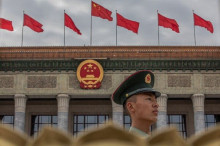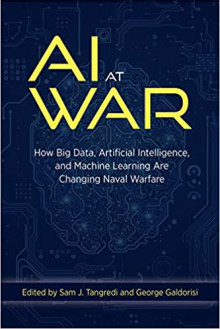Originally Published: April 18, 2021 by Hugh Taylor on Journal of Cyber Policy
AI at War: How Big Data, Artificial Intelligence, and Machine Learning are Changing Naval Warfare
Edited by Sam J. Tangredi and George Galdorisi
AI at War: How Big Data, Artificial Intelligence, and Machine Learning are Changing Naval Warfare, the new book from Naval Institute Press, offers an ambitious discussion about the US military’s adoption of Artificial Intelligence (AI) and related technology. Edited by Sam J. Tangredi and George Galdorisi, former US Navy officers who now work in naval officer training and strategic planning, AI at War is not a traditional book. Rather, it is a collection of 18 papers on the many aspects of the subject matter.
As one of the contributors put it, soldiers have been wondering what’s on the other side of the hill for thousands of years.
Reading this book is a bit like attending a symposium with 18 panel discussions. Tangredi and Galdorisi have done a great job in curating the material and presenting it in an order that takes the reader through the byzantine collection of interlocking policy issues that surround the technologies. Starting with a quite helpful comparative definition of AI and Machine Learning (ML), the book orients the reader to the underlying technologies, as well as the pre-technology philosophical issues that drove the development of AI and ML in the first place.
This is not a scholarly digression. Rather, as the editors understand, it is impossible to grasp the potential of AI and ML in the military if one doesn’t have a sense of how their foundational ideas have permeated military thinking for centuries. As one of the contributors put it, soldiers have been wondering what’s on the other side of the hill for thousands of years.
The material can be slow-going in places, but this is not a beach read. It’s a serious discussion of what are arguably some of the most significant challenges to have faced the US military in a generation. The book discusses AI and ML as a matter of global great power competition—providing some fascinating insights into the different ways that Russia and China, the USA’s two main adversaries, might use the technologies. In this, the contributors challenge the reader’s assumptions about military use of technology in general. Russia and China have different relationships between their governments and their militaries, so their use of AI and ML will be different. In China’s case, for example, AI is most likely being used as a mechanism to monitor the political loyalty of junior officers.
The book also takes the reader into important dialogues about the realities of developing new AI and ML for the military and implementing them at the level of naval operations. The contributors point out how AI and ML policy will have to navigate the complex institutional and political aspects of the Navy and other service branches. Congressional pork barreling, influential defense contractors and inter-service tensions will very much be a part of AI and ML coming into the mainstream of the Navy. Realism is a must in any discussion of the technologies.
AI and ML policy will have to navigate the complex institutional and political aspects of the Navy and other service branches.
Along the way, the book covers potential AI and ML use cases in the Navy. In this, the contributors highlight areas where AI and ML can make an impact on and off the zone of combat. For example, AI and ML might help with supply logistics, a less sexy but vital area of naval operations that can help win battles. The book also delves into the thorny moral and command issues raised by autonomous weapons.
As the contributors point out, AI and ML are already in use in the Navy. And, new AI and ML tools will be added to the naval technology landscape whether policy planners want them there or not. It’s simply coming in all sorts of new technologies being acquired by the service every year. The challenge will be to identify and pursue a strategically coherent and advantageous overall strategy.
This is a necessary book, because, as the editors explain, there has not been enough discussion of AI and ML in naval circles separate from requests for funding. As the editors and contributors seem to understand, if the matter is not well understood by the leadership of the Navy, the funding of AI and ML research will not be well spent.
Overall, AI at War is a worthwhile and useful contribution to a serious dialogue about the best way to employ emerging AI and ML technologies in the defense of the United States.











